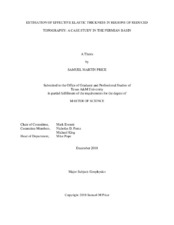| dc.description.abstract | The effective elastic thickness (Te) of the lithosphere is a geometric measure of its flexural rigidity and is determined by isostatic forces, crustal composition, thermal properties, and deformation history. As such, Te can be used to constrain mechanical properties of the lithosphere and reflects the tectonic evolution of both continental and oceanic plates. Inverse spectral analysis techniques such as gravitational admittance and coherence utilize gravity and topography data in conjunction with various plate models to estimate Te across a region. 2-D gravitational coherence has been widely used in continental flexural studies, although recent work has revealed that coherence can significantly bias Te estimations in regions of reduced topography. The Delaware and Midland Basins of west Texas are such regions that have undergone significant but poorly quantified magnitudes of erosion, and application of spectral analysis to estimate Te has proved difficult. A revised method of estimating Te is herein provided that utilizes a modified form of the observed 1-D gravitational admittance. The method introduces a topographic regularization parameter (TRP) to account for the reduction of mid-to-high wavenumber spectral power associated with erosion and interpolation of unevenly spaced data. Implementation of the TRP increases the spectral power of the topography, effectively producing artificial, uncompensated low-to-mid wavelength topography which improves inversion results. A 2-D effective elastic thickness map is produced across the Permian Basin using the revised admittance calculation. Spatial resolution of Te estimates increased utilizing multi-trace 1-D admittance over 2-D coherence. The resulting regional variation in Te reported herein correlates with known geology and provides insight into the future development of Te estimation and geologic interpretation of structures in basins worldwide. | en |


